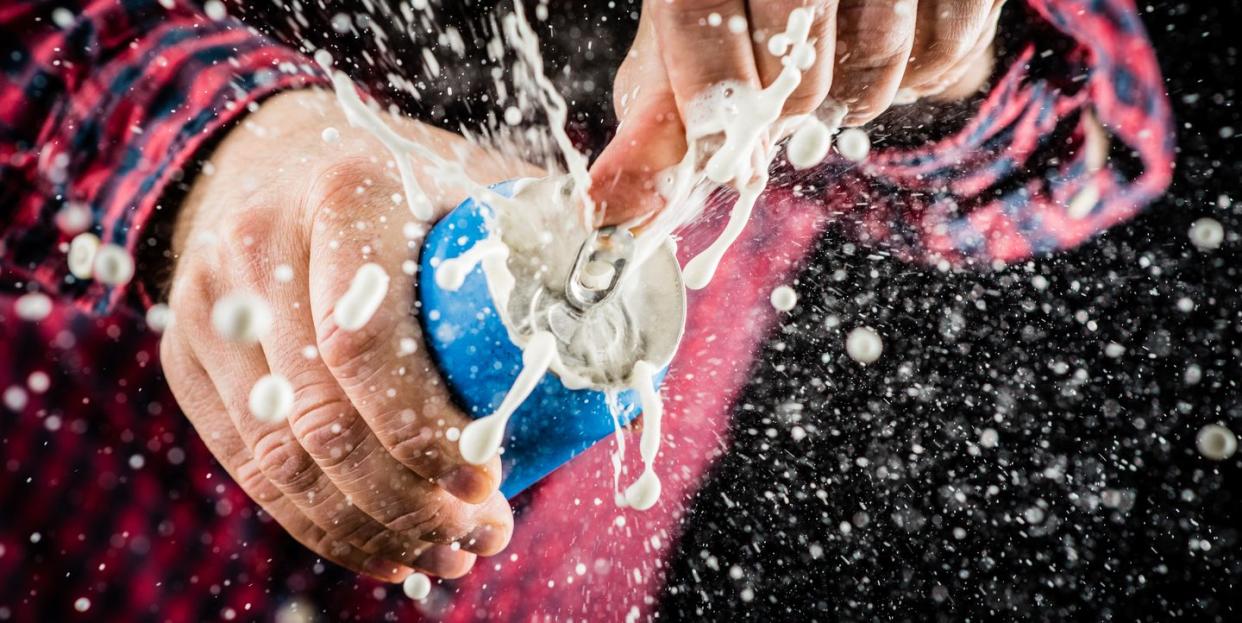Sad: Tapping a Shaken Beer Won't Stop It from Exploding

In a dismaying new study, tapping shaken beer cans did not reduce their potential for explosion and beer loss.
Carbonation is usually the result of carbon dioxide forced into pressurized containers.
Tapping didn't make anything worse, so hey, just keep tapping if it makes you feel good.
Bad news for beer tappers: Tapping your shaken beer doesn’t reduce its likelihood of exploding. In a new study, scientists found no statistically significant link between tapping on a shaken beer and a reduction in explosive foam. “The obvious conclusion is that can tapping does not reduce foaming, a result that must be a considerable disappointment for bicycle-riding, beer-carrying Danes,” MIT's Technology Review reports. Let’s dig in.
Like soda, most commercial beer is carbonated artificially, called “force carbonation” in the industry. This means carbon dioxide is pumped into kegs, for example, and left to dissolve there. Carbon dioxide naturally dissolves in water-based liquids in general, but kegs and other containers are pressurized, which means more carbon dioxide can dissolve. In naturally carbonated beer, the beer is fully brewed, and then a small amount of a yeast fuel, like sugar, is added to individual containers. As the yeast consumes the sugar, the byproduct is natural carbonation.
Some packaged products, like ice cream, are flush against the top of the container when you open it. But most have space, and that space is often filled with some specific gas, not just regular air. Potato chips bags are filled with nitrogen, for example. Bottles of beer and soda have gas at the top, often carbon dioxide. Having free oxygen in the mix can cause problems if the substance in the package is likely to oxidize. Different specific gases have benefits to different products.
In a still, undisturbed environment, beer cans aren’t agitating. The carbon dioxide inside is fully dissolved and pretty stable in that format. When you open a beer without shaking it first, the reaction is similarly gentle, because the carbon dioxide releases uniformly and from its dissolved tiny pockets. When you pour a beer, especially on a conscientious angled pour, there’s not much more agitation.
But in a shaken beer, the equilibrium inside the can is disrupted. Shaking allows the carbon dioxide to break away from the oxygen atoms that allowed it to dissolve in the first place, and instead of uniform, tiny pockets, larger bubbles join up. When you open the can after that, the bubbles force their way out of the depressurized can and carry most of your beer with them. The colloquial idea with tapping is that you can release those newly created bubbles to float to the surface where they won’t make a splash when they escape.
To test the idea, Danish-led scientists took 1,000 cans of (donated!) beer, divided them into shaken and unshaken, then sorted the shaken beers into tapped or not tapped. The beers were shaken by a mechanical arm for two full minutes. Scientists tapped the beers three times on the side with just one finger. All 1,000 beers were opened in the same way: first weighed, then opened, mopped of any spillage, then weighed again.
Alas, the results were disappointing. “For shaken cans, there was no statistically significant difference in the mass of beer lost when tapping compared to not tapping,” the scientists report.
Technology Review offers several theories why tapping might not work in this study, including inconsistent force in tapping or even chemical ideas about the beer itself. Beer protein might keep even larger, shaken bubbles from breaking free to the surface while the can is closed. Either way, the subject warrants more study, and it’s the most classic kind of black box problem—catnip to scientists for thousands of years.
You Might Also Like

